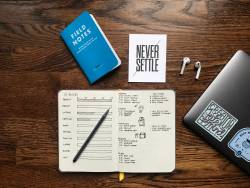
Don't Think Positive. Try the WOOP Technique Instead.

How to bring your wishes to life: stop dreaming and start doing.
Social media is awash with quotes like “positive vibes only” or “live the life of your dreams.” Not only are these lines vapid, but they’re also not doable.
It’s not possible to be a human and experience only positive emotions. We’re way too complex and messy for that.
Living the life of your dreams requires constant work and effort. And most importantly, a plan of action.
Does that mean everything is pointless and we’re all doomed?
Not at all.
Because that would be negative, and that option doesn’t serve us either.
Like Goldilocks, there is a third option that is just right.

The problem with positive or negative thinking.
We’re all aware that negative thinking can kill our motivation and keep us from reaching our goals. But positive thinking can be a slippery slope, too.
Positive thinking can trick your brain into thinking you’ve already achieved the thing you want. You imagine achieving your goals so well, your brain thinks it’s real. So the brain relaxes. Then you’re less motivated to keep working toward that goal.
In a word, positive thinking is demotivating.
Do you feel yourself becoming more negative just reading that?
Stick with me.
The problem with positive and negative thinking is that they are both demotivating because they are driven by emotions. And emotions take up a lot of mental energy.
This emotional drain can prevent you from taking action on your dreams and goals.

A new way of thinking.
So if positive and negative are both bad, what do we do? Like our pal Goldilocks, we seek the middle ground.
In this case, that’s neutral thinking.
In his book It Takes What it Takes, Trevor Moawad proposes neutral thinking as a way of rewiring our brains. It could help us live better, more productive lives, even in times of crisis and high pressure.
Neutral thinking requires taking the emotions out of your thinking. Neutral thinking is judgment-free thinking. It does away with labels like “positive” or “negative”.
It frees up your time and energy to focus on your dreams and goals.
Now let’s take a look at a framework that will help you reach those dreams and goals: the WOOP technique.
What is WOOP?
In her book Rethinking Positive Thinking, Gabriele Oettingen introduces the WOOP technique.
According to the author’s website, “WOOP is a science-based mental strategy that people can use to find and fulfill their wishes, set preferences, and change their habits.”
WOOP is based on twenty years of research in the science of motivation. It stands for:
Wish
Outcome
Obstacle
Plan
WOOP operates from the theory that the internal obstacles that we think keep us from achieving our dreams are actually the key to realizing them.
The WOOP technique uses two tools:
- Mental contrasting. Mental contrasting means visualizing a positive outcome while also visualizing the internal struggle that may keep you from achieving your goal.
- Implementation intentions. Once you understand your goal and the obstacles you may encounter, you create your implementation intentions. This is an explicit statement of when, where, how a goal will be reached.
How do I use WOOP?
Wish: Start with a wish you feel is the most important. This wish should be something that is both challenging and feasible. Sum your wish up to 3-6 words.
Let’s say your wish is to become healthier.
Outcome: Next, envision the positive benefits of fulfilling that wish.
If your wish is to become healthier, maybe the outcome is that you lose weight and have more energy.
Obstacle: The next step is to identify the internal obstacles that prevent you from realizing this dream. We have the most power and control over our internal obstacles--but only if we can clearly identify them.
When you visualize obstacles, your brain sees a question it must answer. It sees a puzzle it needs to solve. Even without you noticing, it starts finding a solution to solve or prevent the obstacle.
How cool is that?
Keep in mind that if an obstacle feels too big, it is most likely made up of several smaller obstacles. Tackle those and you’ll eventually be able to overcome the larger obstacle.
In our example of becoming healthier, a possible obstacle to becoming healthier is craving sweets or junk food.
Plan: The final step of the WOOP technique is to create a plan.
But not just any plan will get you there. This is where you apply the implementation intentions from earlier in the form of an “if [X], then [Y]” statement.
This formula creates a plan for how you will act when you encounter those obstacles you identified.
For example, in your wish to become healthier, you realized that your love of sweets and junk food was going to be an obstacle. To plan for this, you could say:
“If I start to crave sweets or junk food, then I will put on my running shoes and go for a run instead.”
This formula will act as a triggering mechanism.
When you find yourself tempted by sweets or junk food, you already know how you will respond. No need to get those pesky emotions involved--just follow your plan.
As the saying goes, “when you fail to plan, you plan to fail.”
The takeaway
The power of the WOOP technique is that it doesn’t rely on positive thinking to achieve goals.
Nor does it deny negative thinking.
WOOP combines the motivating powers of both positive and negative thinking to create a tool for action. A tool that you can use to make your wishes come to life.














